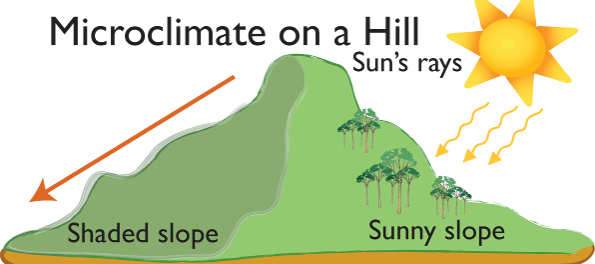microclimates
MICROCLIMATES ARE climates of small areas, such as gardens, cities, lakes, valleys, and forests. A microclimate is an expression of the temperature, humidity, and wind within a few feet or meters of the ground. Such expressions exist because surfaces vary in their ability to absorb, store, or reflect the sun's energy, making some areas warmer or colder, wetter or drier, or more or less prone to frosts. Microclimates may be natural or human made. They are important for their effects on comfort, crops, and natural surroundings.
Microclimates can extend for several miles because of the presence of large bodies of water, urban areas, and topography. Large bodies of water, such as the Great Lakes, Chesapeake Bay, and the ATLANTIC OCEAN ,moderate temperatures of adjacent inland areas. Such water bodies store huge amounts of heat during the summer and release it slowly in winter. Consequently, land areas near the water tend to have low temperatures in winter that are not as cold or prone to fall and spring frosts. Small lakes and bays have the same but less extreme effects. Urban areas also have microclimates. In winter, buildings, parking lots, and streets of cities absorb heat during the day, and then radiate it back into the air at night. Temperatures may be moderate enough to lengthen the growing season slightly in urban areas. In summer, the heating affect of concrete walls, metal and tile roofs, and asphalt parking lots can create sweltering temperatures. The excessive heat dries soils, wilts plants, and endangers the health of infants and the elderly. Topography also affects microclimates. In the Northern Hemisphere, south-facing slopes receive direct rays from the sun and are therefore warmer and drier than north-facing slopes. Additionally, cold air, which is heavier than warm air, tends to spill down mountain slopes and pool in valleys at night. Some valleys are 10 degrees F (18 degrees C) cooler than adjoining slopes on winter nights. Such valleys are at risk to frosts in late spring and early fall from the downslope drainage of cold air.

Microclimates can also be much smaller. The backyard has an assortment of possible small-scale microclimates. Surfaces of homes, balconies, rooftops, paved surfaces (such as patios, driveways, and sidewalks), lawns, trees, and soil types have subtle effects on the temperature, humidity, and motion of air. Like urban areas, a home absorbs heat during the day and radiates it back at night. Like mountain slopes, the side of a home facing the sun receives more solar energy and is warmer than the opposite side. Less cold-tolerant trees and shrubs are better suited to the side exposed to direct sunlight; hardier plants that are less prone to spring frosts can survive the cooler, shady side of the house. The eve of a smartly built roof hangs out over the windows just enough to shade the windows from the “high” sun of summer, but the overhang is not too far to block the “low” sun of winter. Fences, walls, and large rocks protect plants from wind and radiate heat. In winter, paved surfaces around the home absorb the day's heat and reradiate it at night, moderating nocturnal temperatures. The same solid surfaces also absorb and reradiate heat to moderate winter temperatures and to raise summer temperatures.
Gardeners, architects, and farmers change the ground surface (such as by changing the reflectivity or heat transmission of the surface or by modifying surface roughness) to create microclimates. Human-made microclimates can be deliberate or unintentional, large or small in scale. For instance, a skillful gardener creates several small-scale microclimates in a single garden to assure a variety of attractive flowers, shrubs, and trees. The gardener knows that certain plants benefit from the coolness of shade trees; other plants require windbreaks for protection from desiccating winds; and plants that are frost sensitive do better near walls or large rocks that absorb and reradiate heat. Architects design landscapes, homes and office buildings to take advantage of sunlight, solar energy, wind direction, and water drainage.
Farmers utilize microclimates in similar ways in large fields; they select crops according to field exposure to sunlight and wind, as well as moisture retention capacity of the soil. Some of the largest changes that people make to microclimates are unintentional results of widespread suburbanization, forest clearance, and agricultural expansion. Alterations of microclimates will not affect the general climate of a region, but the change can and does result in large local changes in climatic conditions.